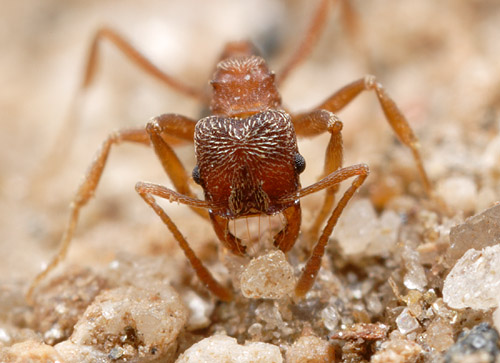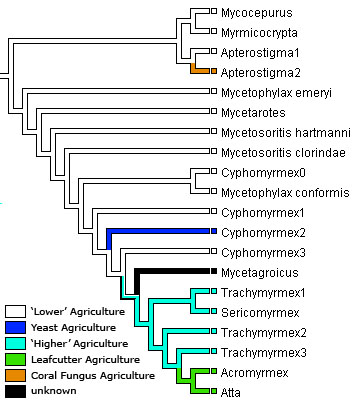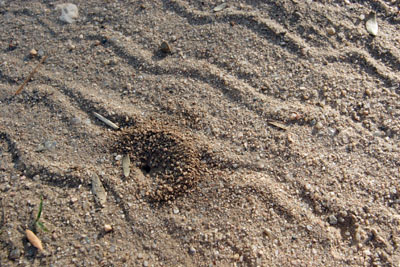
Kalathomyrmex emeryi (Forel 1907), Argentina.
In Zootaxa last week, Christiana Klingenberg and Beto Brandão introduced to the world an entirely new genus of fungus-growing ant, Kalathomyrmex. Yet the single species, K. emeryi, is a widespread neotropical insect that has been known for over a century. In fact, I photographed it twice during my recent trip to Argentina. How does this happen, a new genus devoid of novel species?
The answer is understandable in light of the distinct pattern of evolution among the fungus growing ants, revealed in a 2008 study by Ted Schultz and Sean Brady:

Simplified phylogeny of the attini, from Schultz & Brady 2008
The history of the attine ants is marked by a series of innovations. Ants associate with fungus. Ants develop specialized relations with different types of fungus. Ants start to harvest live vegetation. Ants develop morphological worker subcastes. And so on.
At each change, the novel trait is accompanied by morphological alterations. The renovated lineages possessing the new traits evolve away from the older forms. It's a delightful evolutionary tale. Yet it's also the perfect storm to foment a taxonomist's nightmare: morphologically distinct groups that are not each other's closest relatives but instead the residue of lineages that simply never acquired the new adaptations.
Consequently many of the existing attine genera- Mycetophylax, Mycetosoritis, Cyphomyrmex, Trachymyrmex- are not natural groupings but artifacts of evolution. The leftovers, as it were.

The small entrance mound of a K. emeryi nest in a sandy road.
Bringing attine taxonomy into accord with the phylogeny will not be an easy task. It will necessarily entail finding characters among groups of markedly similar ants. Klingenberg & Brandão's paper is the first salvo in the effort: they've tackled the forms previously included in Mycetophylax.Â
Kalathomyrmex was erected to house the oldest lineage in the disorderly phylogenetic splatter that was Mycetophylax and comprises a single species, emeryi, first described by the Swiss myrmecologist Forel. It is defined by a pattern of clypeal setae not shared by the others. Not the most obvious character, but it does seem to work.

Stronger than you: a K. emeryi worker performs nest maintenance.
K & B also resurrected an older genus, Paramycetophylax, for the rare Argentinian ant P. bruchi. Mycetophylax in the strict sense now includes only a smattering of species that nest in the sand along Brazil's coastlines and rivers, as well as a species or two that had been waylaid in Cyphomyrmex for a few decades. With any luck this new scheme, firmly rooted in phylogeny, will herald a new era of stability for the taxonomy of fungus-growing ants.
Incidentally, I've discovered that I should never leave the computer for more than a week, ever again. The sheer volume of new ant research during my absence will be impossible to catch up with, much less blog about.
Source: Klingenberg, K., Brandao, C. R. F. 2009. Revision of the fungus-growing ant genera Mycetophylax Emery and Paramycetophylax Kusnezov rev. stat., and description of Kalathomyrmex n. gen. (Formicidae: Myrmicinae: Attini). Zootaxa 2052: 1-31.
- Log in to post comments

It could be that your absence causes the flood of new research and that if you don't leave your computer from time to time myrmecology will grind to a halt.
Wonderful blog and pictures.
Wow. Great post!
Just what I was looking for! I was using the KLINGENBERGâ thesis for my ants determinations.
I found three in La Pampa, Argentina:
Mycetophylax morschi (Emery, 1887)
Kalathomyrmex emeryi (Forel, 1907)
Paramycetophylax bruchi (Santschi, 1916)
I saw other post that you were here⦠the next say me and I can accompany you in your campaign.
Best regard
Justo lo que buscaba! Estaba usando la tesis doctoral de KLINGENBERG para mis determinaciones.
Encontré tres en La Pampa, Argentina:
Mycetophylax morschi (Emery, 1887)
Kalathomyrmex emeryi (Forel, 1907)
Paramycetophylax bruchi (Santschi, 1916)
Vi en tus post que estuviste por aquÃ, la próxima dime y te acompaño en tu campaña.
Saludos cordiales,
Rodrigo
I am desperately looking for fresh material of Paramycetophylax bruchi. The previous poster, Rodrigo Tizón, mentions he has collected these. Rodrigo, would it be possible for you to send me alcohol-preserved specimens? I would be INCREDIBLY grateful! You can contact me at schultzt[at]si.edu
I need to add this species to the attine phylogeny described above!
Thanks!
Ted Schultz
Ted!
No problem. I will have contact with you now.
Bye
Rodrigo
Hola, a quienes postearon antes, yo coleccione Paramycetophylax bruchi de todas las castas en Chubut, zona arida, y me gustaria saber actualmente si el genero se sinonimizo o aun se amntiene, es que mi material bibliografico es viejo y muy pobre, aun asi, sigo juntando datos, agradeceria intercambiar informacion con alguien.
you may post more pictures and diagrams to make us understand better.